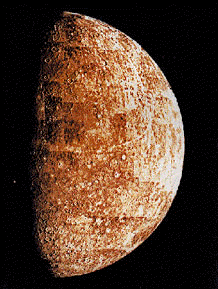This is what an artist thinks MESSENGER will look like in orbit around Mercury. The white sunshade is on the left side of the spacecraft.
Image courtesy NASA/Johns Hopkins University Applied Physics Laboratory/Carnegie Institution of Washington.
MESSENGER Mission to Mercury
MESSENGER
is a spacecraft that will study Mercury;
the planet closest to the Sun. MESSENGER will blast off from Florida in early August 2004. The spacecraft will go into orbit around Mercury in March 2011. It will study Mercury from orbit for about one year.
MESSENGER is only the second spacecraft ever to visit Mercury. The first was
Mariner
10. Mariner 10 flew by Mercury three times in 1974 and 1975. Mariner
10 took pictures of about half of Mercury. One of MESSENGER's main goals is
to take pictures of the rest of Mercury.
Besides taking pictures, MESSENGER will study the surface and interior of
Mercury. It will also measure Mercury's magnetic
field. Mercury is very dense and has a large core. Scientists hope this
new spacecraft will help us learn why. They think MESSENGER will also help
us learn more about the formation of
Mercury, and how the planet has changed over time.
Why will MESSENGER take seven years to reach Mercury? NASA needed to keep
the cost of the mission low, so they had to use as little fuel as possible.
MESSENGER will fly past Earth once, Venus twice, and Mercury three times before
it goes into orbit around Mercury. When it flies by planets, the gravity of
the planets will help steer MESSENGER in the right direction without using
fuel.
Sunshine is very hot near Mercury. MESSENGER has a special sunshade that will
keep the spacecraft from getting too hot. The sunshade is like a beach umbrella!
You might also be interested in:

What types of instructional experiences help K-8 students learn science with understanding? What do science educators teachers, teacher leaders, science specialists, professional development staff, curriculum designers, school administrators need to know to create and support such experiences?
...more
The Mariner 10 mission (USA) to Mercury was launched on November 3, 1973 and arrived at Mercury on March 29, 1974. The spacecraft made three separate passes by the planet, and obtained about 10,000 images
...more
Images of the surface of Mercury obtained by Mariner 10 showed a planet covered with craters, looking very much like the Earth's Moon. During its three passes by the planet, Mariner 10 took pictures of
...more
Mercury has a radius of 2439 km (1524 mi), and the metallic iron-nickel core is believed to make up about 75% of this distance. Measurements of the planet's magnetic field made by Mariner 10 as it flew
...more
Mercury, like the other planets, is believed to have formed in the earliest stage of the evolution of the solar system as dust came together to form even larger clumps and eventually small planets or
...more
The Advanced Composition Explorer (ACE) was launched at 10:39 a.m., August 25, 1997. The ACE was launched aboard a Delta II rocket. Mission lifetime is expected to be five years for the overall mission.
...more
To learn more about a specific mission from the Apollo program, the most successful and expensive space program in human history, select one of the links below: Apollo 1 Apollo 7 Apollo 8 Apollo 9 Apollo
...more
The Apollo space program, scheduled for its first launch on Feb. 21, 1967, started in tragedy. On Jan. 27, 1967, astronauts Gus Grissom, Ed White, and Roger Chaffee were executing a dress rehearsal when
...more















